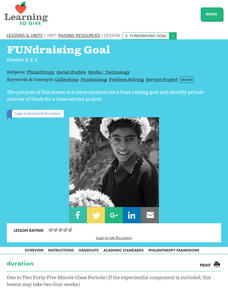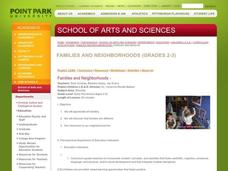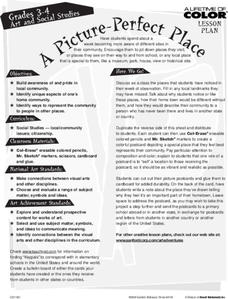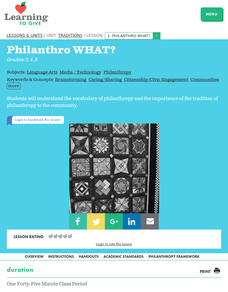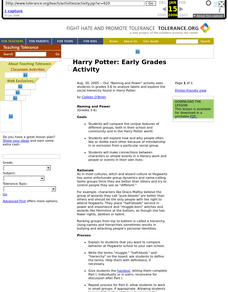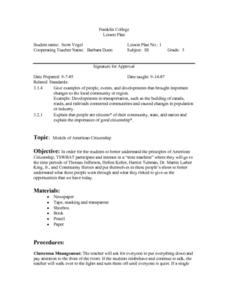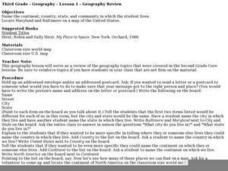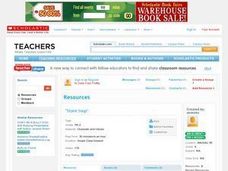Curated OER
Where Do You Work?
In this language arts and social studies worksheet, students read 20 clues about a person's occupation. Students use the word bank to locate where each person works. Example: I am a nurse. I work at the ___(hospital).
Curated OER
Involving Community Members, Parents, and Community Agencies in Student Learning
Students predict and estimate the number of moose shot by people between the years of 1986-1990. They analyze data and statistics, construct bar graphs, and conduct research on the Alaskan moose.
Curated OER
FUNdraising Goal
Pupils decide how much money is needed to help a family in their community. They develop a way to raise funds and follow through with the project. They identify private sources of funds in their community.
Curated OER
I Am Me and More! Assemblages and Pepon Osorio
Pupils discuss their role and importance of being a part of a community. After listening to a story, discuss how an artist's memories affected his pieces. Using the internet, they research the different roles of community members.
Curated OER
Personal Culture
Students investigate personal culture. They go throughout the community taking pictures and saving the images to create a personal photo book. The information can be displayed in either a digital or hard copy. The goal of the lesson is...
Curated OER
Families and Neighborhoods
Young scholars study family structure. In this family structure lesson, students read the book The Family Book and discuss families. Young scholars create a bulletin board of family photos and draw their families on paper. Students dance...
Curated OER
Department Duties
Third graders identify three kinds of health or safety workers and explain how they help protect the health of the people in a community.
Curated OER
The Big O
Students investigate the characteristics of a community. They investigate the characteristics of the Omaha community through internet research and discussion. Students create books about their community.
Curated OER
Dividing the Philanthropic Shares
Pupils define who volunteers are the and the types of jobs that they do. They identify various groups who volunteer in their community, and locate them on a city map.
Curated OER
A Picture-Perfect Place
Students make a post card of a special place in their community. They write about the place they have drawn, telling why they feel it's an important part of their hometown. They address and send to another school.
Curated OER
No One Should Be Hungry
Students in grade K-3 prepare a meal once a week for 16-20 residents at Welcome House, a homeless shelter in South Kingstown, Rhode Island. This Feinstein Kids Can Make a Difference community service project provides students with...
Curated OER
Mud Maps
Learners discuss the location of stores, buildings, and homes in their community. Afterwards, they create a 'mud map' demonstrating the route from one point to another. In pairs, students read travel directions from a brochure, while...
Curated OER
Philanthro What?
Pupils discuss what it means to be a philanthropist and how important philanthropists are to the community. They discuss the tradition involved in philanthropy and create a show and tell "Philanthropy Teaching Quilt" using the various...
Curated OER
Ethical Consumer Choices in the Global Village
Students identify an issue and provide several reasons to support a position. They describe ways members of a community meet one another's needs. Students explain their roles, rights, and responsibilities within the community.
Curated OER
Harry Potter: Early Grades Activity
Students analyze labels and explore the social hierarchy found in Harry Potter. They expore inclusion and exclusion in social groups.
Curated OER
Texture Towns
Students explore different kinds of communities as well as identifying and discussing the attributes of their own neighborhood. They make choices about what kinds of shapes best create the look of the type of community they wish to...
Curated OER
Models of American Citizenship
Third graders investigate the concept of American citizenship by pretending to time travel. They travel back in time to visit the eras of Thomas Jefferson, Hellen Keller, Harriet Tubman, Dr. Martin Luther King, Jr., and community heroes....
Curated OER
Geography Review
Third graders name the continent, country, state, and community in which they live. They locate Maryland and Baltimore on a map of the United States.
Curated OER
Mudras and Sign Language
Students compare the languages of the ancient Japanese people and the American deaf community, two cultures that utilize hand signs in this lesson for the early elementary classroom.
Curated OER
Stone Soup
Learners explain how various cultures affect the interactions that take place in a community. They compare and contrast families by where they live, the jobs they hold and the types of food they eat. Using examples, they sort goods and...
Curated OER
Memorial Day Fun
Students research Memorial Day and complete activities about the day. In this Memorial Day lesson, students discuss the definition of the word 'memorial' to understand its meaning. Students create flags for the day and listen to a...
Curated OER
Calling All Tribes
Learners inquire about past and present traditions and customs and formulate their own perspectives. They become actively involved in the studying process and explore the different aspects of the topic.
Curated OER
Types of Transportation
Students study different types of transportation including specialized trucks. In this transportation instructional activity, students look at a landscape picture map (not included) and identify all of the modes of transportation they...
Curated OER
Can Young Children Distinguish Between Living and Non-living Things?
What does it mean to be living? Help your young scientists identify living and non-living things as a result of their learning through discovery. Observation of and interaction with a set of natural phenomena in their community will make...


